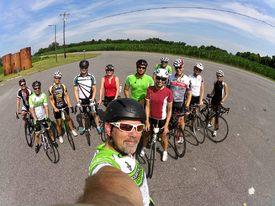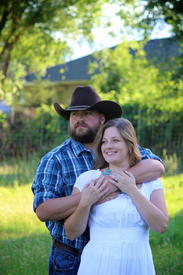Shin Splints Ruining My Day :(

wenchyh
Posts: 6 Member
I used to be a fit bunny, now i'm a fatty bunny, so I need to lose some considerable weight......
I started walking to work and back a few days a week, 20 mins each way, so nothing too hard and I'm playing netball again, training once per week for an hour and a half plus a match every week for an hour.
Its all perfect, i'm losing weight nice and steadily, its not too much but not too little and then the shin splints come back Now my coach has advised at least a week of netball and to rest my legs
Now my coach has advised at least a week of netball and to rest my legs 
I've ordered some base layer calf guards and i've been resting all week, well driving my fat bum to work rather than walking.
Its getting me down It was all going so well
It was all going so well 
Any tips on keeping the shin splints at bay please?
I started walking to work and back a few days a week, 20 mins each way, so nothing too hard and I'm playing netball again, training once per week for an hour and a half plus a match every week for an hour.
Its all perfect, i'm losing weight nice and steadily, its not too much but not too little and then the shin splints come back
I've ordered some base layer calf guards and i've been resting all week, well driving my fat bum to work rather than walking.
Its getting me down
Any tips on keeping the shin splints at bay please?
0
Replies
-
ice those shins when they hurt and really good shoes. Make sure you are walking correctly,heel to toe,and using your calf muscles,thats what my PT friend has told me anyway.She sees alot of people that just plop along using their thighs more then the rest of the leg and it causes all kinds of issues,and then running around in $10 no support shoes.This is what I have been told so not real life advice,but it makes sense.0
-
I would invest in a trip to the osteopath to check out the underlying cause. Good luck, injury sucks big style.0
-
This happens with a lot of runners who aren't wearing the proper shoes. I would go to your local running store and get fitted for shoes that fit YOU properly (and make sure to tell them you'll be walking, not running). Good luck!0
-
I used to be an Irish dancer (think Riverdance-style, but nowhere near that level), and during performance season, the shin splints were murder. Ice, warm-up, stretch, and all that good stuff helps. If it feels okay on your knees and hips, try walking around on your heels (with your toes up off the floor) for about 5 minutes at a time. We'd all do that a couple of times a day, and it helped more than anything else.0
-
A combination of these three approaches will usually help most people recover from shin splints and experience less pain:
1. Active Rest is the first mode of treatment for all types of shin splints. "Active rest" does not mean you must stop running or exercising. Many people make the mistake of not exercising for many weeks and then attempting the same distances that got them into trouble the first time. Rather, rest should be active to relieve stress on painful areas, yet maintain your conditioning. Completely stopping activities may give temporary relief, but injuries are likely to resurface with resumed activity, especially if you are trying to make up for lost time.
Active rest activities include low-impact exercises like the elliptical trainer, stationary cycling, and swimming. Try any activity that doesn't involve the same muscles as running, and that doesn't require repetitive impact on hard surfaces. “Water running” is another effective way to rehab these injuries: Use a flotation device and run in the deep end of a pool. You can move to the shallow end, running on the bottom, as your pain begins to improve.
Remember, the human body is truly remarkable in its ability to adapt, BUT it prefers to adapt to gradual changes over time. With slow, steady progress, your muscles, tendons and other soft tissues will better adapt to the stresses you are asking of it.
2. Ice can be very helpful during the acute phases of your pain. This is especially true if your shin splints are accompanied by redness, localized tenderness, or swelling. Try an ice massage by holding an ice cube in a washcloth and rubbing the swollen, sore area for 10 to 15 minutes. Another trick of the trade is to use a bag of frozen vegetables.
Remember not to exceed 10 to 15 minutes each time you ice, and always wrap ice cubes, frozen veggies, and store-bought gel ice in a towel or washcloth to avoid burns and frostbite. You can repeat icing every few hours as needed.
3. Stretching and strengthening the calf muscles can help prevent and treat shin splints. Here are some stretches that will target this area. (Hold each stretch for 10-15 seconds, repeating 2-3 times.)
Calf stretch: Step forward into a half lunge, toes pointing forward. Your forward leg should be bent and the back leg should be straight. Stretch the calf of your back leg by pressing your heel down toward the floor, keeping the forward leg bent and stationary. You should feel a stretch in the calf of your back leg. Repeat on opposite side.
Hamstring stretch: Begin by standing upright, feet under hips, toes pointed forward. Place the heel of your right forward so that your toes point upward. Keep your back leg slightly bent and abs tight to help with balance. Place your hands on your front thigh. Keeping torso straight, bend over from the waist, lowering your upper body towards your extended leg until you feel a stretch in the hamstring of your front leg. Repeat on opposite side.
Remember, these are general guidelines for the self-treatment of shin splints. The underlying problem is that your body is unable to cope with the stress of exercise that you are placing on it. Be patient; it will take time—sometimes weeks or months—to resolve. Never attempt to train through the pain, and always stop when your body tells you to. If you are not improving with this home treatment, if you worsen significantly, or if the pain becomes a continuous discomfort (even at rest), revisit your health care provider.
Source: http://www.sparkpeople.com/resource/fitness_articles.asp?id=6110 -
When I started running again I got shin splints terribly and I was having trouble walking after a run. I used ice for 15 minutes at a time as needed and got myself some new shoes. I also got a compression sleeve for the affected leg. I kept running just at less mileage and added in calf raises to strengthen my calf and shin muscles. As my legs got stronger my shin splints gradually disappeared. I still have occasional pain from time to time but nothing like it used to be and then I know that I have just pushed it a little too far and I dial it back for a couple of days. I hope you start to feel better. I know how much they can suck!0
-
You should see your physio, he can assist with your shin splits and would be happy to give you some tips on what you can do while the splints are recovering0
-
The foam roller is fantastic for shin splints!0
-
Thank you all for your support and feedback, I appreciate it very much.0
-
Calf supporters are the greatest thing God gave a runner with shin splints. Buy a pair, they're cheap and they rock.
Rigger0 -
You may want to get some blood work done if the shin splints keeps coming back. You may be deficient in certain vitamins etc.0
-
Majority of the time shin splints are caused by your shoes. Whether it being the wrong type or they are just worn out. Running shoes wear out quickly.0
-
Ice!!0
-
You can also try doing some active stretching before you work out and make sure you warm-up properly. Also agree that getting fitted for shoes will help.0
-
http://www.fitpowernation.com/3/post/2012/05/shin-splints.html
I see them every day as an athletic trainer. Here's a blog I wrote last year.0 -
Another vote for shoes with the help of an independent running shop where they can analyze your pronation. (Stretching, too.)0
-
there are 3 main causes of shin splints : bad running form, improper footwear for your body/gait issues, and weak muscles.
when i first started running again the first 2 weeks my shins killed me and i figured out it was because of #3. not that the muscles were weak since i could walk fine, but with extra weight it took some time for them to get used to the additional pounding.
what help was wearing calf sleeves on recovery days and consistent icing, stretching massaging. it finally took about 2 weeks (of 3 days a week running) where my shin pain went away and i didnt need the calf sleeves anymore.
good luck!0 -
Great advice. Shin splints are usually caused by either doing too much too soon or using poor quality, worn out shoes. So, do the elliptical or rowing machine, or even swim for awhile, until the pain is gone. Then, start back with less mileage and intensity. The ice is very important and ibuprofen can be helpful, too. Use real ice, not " icy hot".A combination of these three approaches will usually help most people recover from shin splints and experience less pain:
1. Active Rest is the first mode of treatment for all types of shin splints. "Active rest" does not mean you must stop running or exercising. Many people make the mistake of not exercising for many weeks and then attempting the same distances that got them into trouble the first time. Rather, rest should be active to relieve stress on painful areas, yet maintain your conditioning. Completely stopping activities may give temporary relief, but injuries are likely to resurface with resumed activity, especially if you are trying to make up for lost time.
Active rest activities include low-impact exercises like the elliptical trainer, stationary cycling, and swimming. Try any activity that doesn't involve the same muscles as running, and that doesn't require repetitive impact on hard surfaces. “Water running” is another effective way to rehab these injuries: Use a flotation device and run in the deep end of a pool. You can move to the shallow end, running on the bottom, as your pain begins to improve.
Remember, the human body is truly remarkable in its ability to adapt, BUT it prefers to adapt to gradual changes over time. With slow, steady progress, your muscles, tendons and other soft tissues will better adapt to the stresses you are asking of it.
2. Ice can be very helpful during the acute phases of your pain. This is especially true if your shin splints are accompanied by redness, localized tenderness, or swelling. Try an ice massage by holding an ice cube in a washcloth and rubbing the swollen, sore area for 10 to 15 minutes. Another trick of the trade is to use a bag of frozen vegetables.
Remember not to exceed 10 to 15 minutes each time you ice, and always wrap ice cubes, frozen veggies, and store-bought gel ice in a towel or washcloth to avoid burns and frostbite. You can repeat icing every few hours as needed.
3. Stretching and strengthening the calf muscles can help prevent and treat shin splints. Here are some stretches that will target this area. (Hold each stretch for 10-15 seconds, repeating 2-3 times.)
Calf stretch: Step forward into a half lunge, toes pointing forward. Your forward leg should be bent and the back leg should be straight. Stretch the calf of your back leg by pressing your heel down toward the floor, keeping the forward leg bent and stationary. You should feel a stretch in the calf of your back leg. Repeat on opposite side.
Hamstring stretch: Begin by standing upright, feet under hips, toes pointed forward. Place the heel of your right forward so that your toes point upward. Keep your back leg slightly bent and abs tight to help with balance. Place your hands on your front thigh. Keeping torso straight, bend over from the waist, lowering your upper body towards your extended leg until you feel a stretch in the hamstring of your front leg. Repeat on opposite side.
Remember, these are general guidelines for the self-treatment of shin splints. The underlying problem is that your body is unable to cope with the stress of exercise that you are placing on it. Be patient; it will take time—sometimes weeks or months—to resolve. Never attempt to train through the pain, and always stop when your body tells you to. If you are not improving with this home treatment, if you worsen significantly, or if the pain becomes a continuous discomfort (even at rest), revisit your health care provider.
Source: http://www.sparkpeople.com/resource/fitness_articles.asp?id=611
If the pain does not improve and doesn't go away, get checked by the doctor. I've seen a lot of stress fractures, especially in young Army recruits. The thinking is that our young people today don't grow up running, playing and doing weight bearing activities. Today's generation grew up with video games and cable television.
I have very strong bones. I grew up in the late sixties/seventies and spent my time riding horses, running, playing sports and generally being a normal,active kid.
I've noticed,here in AZ, school sports are no longer free and PE is no longer mandatory. I think its a terrible crime and we will see the results in next generation's overweight, weak boned adults.0 -
try cycling for some relief while also doing cardio. also, on what kind of surface do you run on?0
This discussion has been closed.
Categories
- All Categories
- 1.4M Health, Wellness and Goals
- 398.1K Introduce Yourself
- 44.6K Getting Started
- 261.1K Health and Weight Loss
- 176.4K Food and Nutrition
- 47.7K Recipes
- 233K Fitness and Exercise
- 461 Sleep, Mindfulness and Overall Wellness
- 6.5K Goal: Maintaining Weight
- 8.7K Goal: Gaining Weight and Body Building
- 153.4K Motivation and Support
- 8.4K Challenges
- 1.4K Debate Club
- 96.5K Chit-Chat
- 2.6K Fun and Games
- 4.7K MyFitnessPal Information
- 16 News and Announcements
- 19 MyFitnessPal Academy
- 1.5K Feature Suggestions and Ideas
- 3.2K MyFitnessPal Tech Support Questions


















